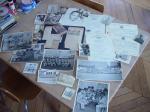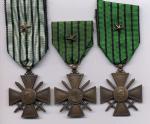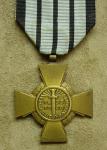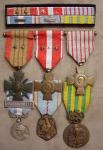-
Posts
2,284 -
Joined
-
Last visited
-
Days Won
6
Content Type
Profiles
Forums
Blogs
Gallery
Events
Store
Everything posted by PKeating
-
Another. One of the press clippings refers to the 555th being invited to march in victory parades with the 82nd by General James Gavin, who did more than many to end segregation in the US Army.
-
I thought some of you might be interested in some snapshots of a group to an African-American paratrooper who served with the 555th Parachute Infantry Battalion, nicknamed The Triple Nickles. James L Mayer was a baseball player - and sometime boxer - who volunteered for the 555th in 1944. Sorry about the small size. PK
-
-
The enamel is damaged but the general quality of this British-made example is very high. I've had it for more than thirty years. In fact, it was the second military badge I ever bought as a kid and I found it on a stall in Portobello Road for the princely sum of .25p. PK
-
Ah, I see. You were asking about the awards P?tain actually held. He was a Commander of the L?gion d'Honneur and held other orders and decorations but I suppose he was stripped of those after WW2. PK
-
-
Obverse. (Sorry about the non-appearance of the other photo. It's really hard to get the images under the KB limit on a Macintosh!)
-
A scarce Vichy-issue Croix du Combattant with the Vichy-style ribbon and the dates 1939-1940 on the reverse. Like the 1939-1940 Croix de Guerre above, this was issued to veterans in 1941 in exchange for their Republican versions.
-
Three types of Vichy Croix de Guerre: on the right, the classic 1939-1940 cross with the green and black Etat Fran?ais ribbon, as issued to veterans who had won the Croix de Guerre in the 1939-1940 War and who remained or re-enlisted in the French armed forces loyal to P?tain's government. On the left, the same decoration but with the extremely rarely seen blue and black variant ribbon which was quickly superceded by the black and green scheme. In the middle is one of the two 'true' Vichy/P?tainist Croix de Guerre, the other being the LVF cross. This type was instituted in March 1944 and bears the P?tainist "Etat Fran?ais" medallion instead of the Republican version normally seen on Croix de Guerre. The reverse bears the date "1944". Only members of the Premier R?giment de France and P?tain's Bodyguard Detachment were eligible for this award and less than two-hundred are believed to have been awarded before the collapse of the Vichy state. Awards were for valour and distinguished service in combat against FFI and FTP partisans and the SAS and OSS units that served with them in the lead-up to and aftermath of the invasions of Normandy and Provence. PK
-
No Paul, I regret to say that I never had the privilege of meeting the man whose group is the first I posted. Nor did I meet the second man although I acquired the medals from his nephew. Thank you for your remarks, Christophe. ?a me pla?t que vous aimez ces deux groupements de d?cos et m?dailles. I suppose I had better continue in English as this is an anglophone site! I will ask Arthus Bertrand about the clasps, and also Marie Stuart, in the Palais Royale. Thank you very much for posting the information about the order of 8.9.1981. Fascinating! Bernhard, you can wear the cross if entitled to do so. As far as I know, you can make an application to the ministry but it is usually much quicker just to buy it from one of the shops in Paris, like the ones I mentioned! I just purchased several French decorations and medals for Patrick Churchill, head of the Commando Veterans' Assocation, who served with N? 4 (French) Commando in 1944 and 1945. There were a couple he didn't even know he was entitled to wear! PK
-
La Croix du Combattant Voluntaire de 1939-1945 was created on 1.2.1953. According to my sources, the dates were supressed after this issue of the cross was awarded for Korea. I cannot find any reference anywhere to clasps for this decoration or to its suppression in 1970. Are you sure that the clasps to which you refer were not intended for service medals? There is no tradition of clasps - barettes - being worn on the ribands of French valour and war service crosses. Above, just for interest's sake, is a 1939-1945 issue in a group to WW1 veteran who fought in the 1939-1940 war as a volunteer and then, as you can see, in the Resistance before he was deported to a concentration camp. He survived. Below is a group to a professional soldier who served in the Far East during WW2 with the FFL and went on to serve in Indo-China and then, as the Valour Cross with the citational stars shows, in Algeria. Note that he has the small, so-called FFL version of the Colonial Medal with the clasp for the Far East. In fact, he got his clasps the wrong way around: the Indochine clasp - which relates to his WW2 service - should have been on the Colonial Medal while the Extreme-Orient should have been on the 1939-1945 War Commemorative Medal. Note too that French personnel in Indo-China in the early 1950s received a medal dedicated to that conflict. His Colonial Medal should also have the Algeria clasp but he never got it and never bothered sending off for it afterwards. The point is that les barettes were instituted for campaign and colonial service medals and, latterly, the Overseas Service Medal, instituted in 1962 to replace the Colonial Medal. The only add-ons one sees on the ribands of crosses are Palm leaves and Stars. I tend to believe that veterans of WW2, Indo-China, Korea and later conflicts might have acquired unofficial clasps or clasps intended for other medals and affixed them to their crosses for wear at reunions and commemorative events but these conflicts were all recognised by official campaign medals and clasps. I would be very interested in seeing any official orders referring to clasps for the undated Volunteer Combattant's Cross as issued after the Korean War. PK
-

EK 1939 iron cross 1939 G Williamson Book search
PKeating replied to knopfler's topic in Germany: All Eras: The Iron Cross
He was referring to the Iron Time book. PK -

SS Heimwehr ID tag
PKeating replied to Avitas's topic in Germany: Third Reich: Uniforms, Headwear, Insignia & Equipment
I share Chris Ailsby's concerns. You ought to take this back to the chap who sold it to you for a refund. PK -

SS Heimwehr ID tag
PKeating replied to Avitas's topic in Germany: Third Reich: Uniforms, Headwear, Insignia & Equipment
I wasn't mocking you at all. Sorry if it came across that way. I was merely offering you another perspective on your relationship with this friendly fellow Walter. There's no such thing as a free lunch, Pat, as I am sure you know. If the EKM turns out to be real, then that will be wonderful. I am certainly not an expert but I know a thing or two about EKM and this one worries me, that's all. If it is real, then I will learned something. Regards, PK -

SS Heimwehr ID tag
PKeating replied to Avitas's topic in Germany: Third Reich: Uniforms, Headwear, Insignia & Equipment
Hmmmmm... Uhuh... Who told you that the reverse of EKM carried divisional details? The SS-Heimwehr Danzig was formed from two SS-TK units with about five-hundred volunteers from Freistadt Danzig itself. An unissued EKM would not bear Stammroll and blood group details. The SS-Heimwehr Danzig might have had EKM made up locally from whatever alloy the supplier chose and might have departed from regulations in omitting member #766's company details. But I doubt it. In any case, I think member #766 would have been a trained soldier from one of the two units forming the cadre of SS-Heimwehr Danzig so he would surely have had an EKM issued by his training or parent unit. As for anymore help with this piece, well, all I can tell you is "not in my collection". Fortunately, you are only $50.00 down on the deal and if your local friendly dealer-cum-collector has been selling you original stuff at half-price, don't bother him about this piece of junk. You've made many times the loss back in what you have been buying at half-price. Regards, PK -

SS Heimwehr ID tag
PKeating replied to Avitas's topic in Germany: Third Reich: Uniforms, Headwear, Insignia & Equipment
The "A" is the issuee's blood group while 766 is his Stammroll number. Companies were numbered. There is however no reference to the wearer's company. Of what material is your EKM made? It looks like brass. One would expect land forces EKM to be made of aluminium, steel or zinc. The cadre of SS-Heimwehr Danzig came from SS-Totenkopf-Standarte 4 Ostmark, which was part of the Totenkopfverb?nde. While SS-TK-Standarte 4 Ostmark was formed in Linz in September 1938, a new Sturmbann was raised in Berlin the following month: SS-Sturmbann G?tze, which was detached from the SS-TK-St 4 in July 1939 and sent to Danzig. SS-Sturmbann G?tze had three rifle companies and a machine gun company. The ORBAT of SS-Heimwehr-Danzig was as follows: Stab/SS-Heimwehr Danzig 1./SS-Heimwehr Danzig 2./SS-Heimwehr Danzig 3./SS-Heimwehr Danzig 4./SS-Heimwehr Danzig 13./SS-Heimwehr Danzig 14./SS-Heimwehr Danzig 15./SS-Heimwehr Danzig So, SS-Heimwehr Danzig consisted of SS-Sturmbann G?tze, the Panzerabwehr-Lehrsturm der SS-Totenkopfstandarten and about 500 volunteers from Danzig itself. In other words, of the roughly 1550 men of the SS-Heimwehr Danzig, only a third or so were local men. After the conquest of Poland, the SS-Heimwehr Danzig was taken into the 3. SS-Division Totenkopf, forming the cadre of various sub-units of the division. The SS-TK men from SS-Sturmbann G?tze and the SS-TK Anti-Tank Demonstration Detachment would have had Erkennungsmarke (EKM) issued by their parent units, which in these cases came under the SS-Totenkopfverb?nde. In October 1939, the SS-Totenkopf-Rekruten-Standarte (Dachau) was formed with four battalion-sized sub-units but this is by-the-by. However, the Danzigers who volunteered for the SS-Heimwehr Danzig underwent training in and around Danzig so did the SS-HW Danzig issue EKM at unit level to these men or did they receive EKM through the SS-TK administration? One aspect I find strange is the absence from this EKM of any company designation. If not indiscreet questions, from whom did you purchase this EKM and how much did you pay for it? PK -

Heer Ballonbeobachterabzeichen
PKeating replied to Avitas's topic in Wehrmacht Medals, Decorations & Awards
Not strictly true. I could show you original pieces that look as if they were made yesterday. It is usually a question of investing the time and effort in studying known originals, getting to know the diestruck characteristics like the back of your hand, and applying that dogma to pieces offered to you. Yes, some people will always be fooled by a bit of patina and a good story - like the stories pertaining to the so-called Rounder Knights' Crosses and "L/13 Meybauer" variants - but the Balloon Observer Badge is, luckily, quite a straightforward study subject: it never existed. PK -

Kriegsmarine E-Boat Hat Trick plus one...
PKeating replied to PKeating's topic in Wehrmacht Medals, Decorations & Awards
Thanks guys. You're right about the AS badges, Gordon. I have only ever seen one that was bereft of its finish. The strike quality is really impressive too. PK -

Kriegsmarine E-Boat Hat Trick plus one...
PKeating replied to PKeating's topic in Wehrmacht Medals, Decorations & Awards
-
No particular reason for posting these other than to share them as nice examples of the three types of Schnellboot-Kriegsabzeichen and a quite rarely encountered Rudolf Souval Flotten-Kriegsabzeichen. What's nice about the French-made badge is that it has not been retouched with that garish gold paint like so many of the French KM badges one sees. It is, as the French say, dans son jus. PK
-

EK 1914 1813 EK2 on EBay
PKeating replied to Gordon Williamson's topic in Germany: All Eras: The Iron Cross
Its appearance suggests an issue made between 1860 and 1900. Just a gut feeling, looking at it. PK -

Heer Ballonbeobachterabzeichen
PKeating replied to Avitas's topic in Wehrmacht Medals, Decorations & Awards
I do not doubt for one moment that it is the same as a badge sold by Weitze with an Angolia provenance attached! You have had an expensive lesson for ?2.000,00, which is about $2,500.00. You should take it back to the person who sold it to you and get a refund. It is possible that ex-Leutnant Koch acquired this badge sometime after the war as an example of the badge many balloon observers felt they should be been given and that his sister sold it to you in good faith but it is a $20.00 display item. If you trade it, knowing that it is a fake, to someone who does not know that it is a fake, then that would not be very good. The fact is that this badge is a fake or, to be very precise, a bad rendition of a postwar fantasy piece based, so the story goes, on wartime drawings and a single, oversize studio pattern kept by the original designer after the war, whom Dr Kurt Klietmann interviewed. PK -

Heer Ballonbeobachterabzeichen
PKeating replied to Avitas's topic in Wehrmacht Medals, Decorations & Awards
No proof that any badges were made before May 1945 and lots of anecdotal evidence from veterans that no member of a German balloon observation detachment ever received or wore such a badge although some people believe that nominal awards could have been made, if entries in paybooks are genuine. In any case, this badge is not suggestive of German workmanship. The eagle looks like a puffin. Certainly not one of the more convincing attempts I have seen. Some really well-made badges came out of England about twenty-five years ago and are far more 'dangerous' to inexperienced, gullible collectors than this one. How much did you pay for this badge? PK -

IRISH 1916 SOMME CELEBRATION 2006
PKeating replied to Kev in Deva's topic in The Great War 1914 to 1918
Kev, You should try Leo Cooper, in the UK, or one of those imprints. There are also several publishers in the States who would be interested, I am sure. I will have a think and send you a shortlist in due course. Regards, PK -
Thank you for posting these links and for your efforts in keeping these images available. The ECPA-D - French military archives - in Fort d'Ivry just outside Paris has a wonderful collection of WW1 colour photography. The Americans were also producing colour photographs as this shot of returning Harlem Hell Fighters in 1919 shows. PK












